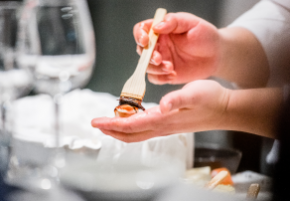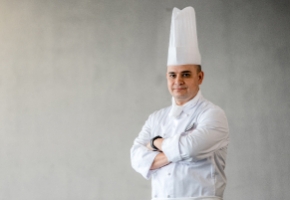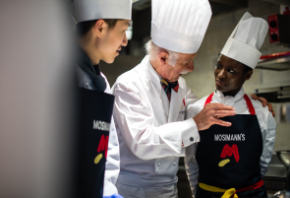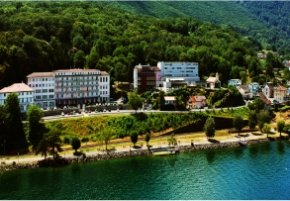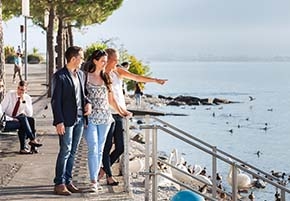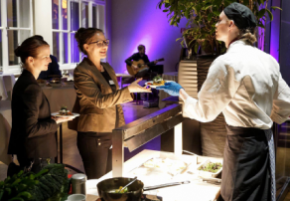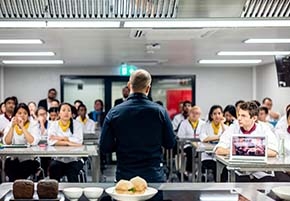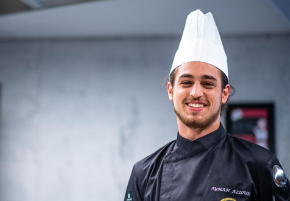- About
- Programs
- Campus Life
- Career Services
- Admissions
- News & Events
- Alumni
The Art of Chocolate Sculpture: Tools and Technique
Master the art of chocolate sculpture with key instructions on tools, techniques, and ideas for crafting, preserving, and displaying chocolate creations.
Key Takeaways
- Chocolate sculpting is the art of transforming melted or solid chocolate into intricate showpieces.
- Essential tools include high-quality chocolate, sculpting tools, molds, heat sources, and protective equipment.
- Key techniques for chocolate sculpting are carving, molding, assembling, decorating, and texturing to create realistic effects.
Chocolate sculpture is a deeply artistic process that transforms chocolate into a medium for creative expression. Chocolate's rich texture and ability to shift between solid and soft make it ideal for crafting three-dimensional art.
British sculptor, photographer, and installation artist Helen Chadwick, known for exploring the theme of the role, identity, and representation of women, summed it up perfectly when she said, “I needed something that would assert a really, really primal physicality that would also be on that edge of alluring, delicious and repulsive. And I just thought, yes, chocolate.”
In this way, chocolate becomes a material language that can be molded, carved, and cast into detailed forms that relay a message to its viewers.
Essential Tools for Chocolate Sculpting
As Benjamin Franklin, one of America's most renowned inventors, wisely said, "The best investment is in the tools of one's own trade."
This advice rings true for any craft, especially the delicate art of working with chocolate. To make chocolate sculptures that are both visually impressive and structurally sound, having the right tools is essential.
Chocolate is a delicate and temperamental material, requiring precision, control, and care—qualities that the right tools can provide. Some of the most important tools for working with chocolate include:
- High-quality chocolate
- Sculpting tools, such as fine spatulas, modeling sticks, and small carving tools
- Molds
- Heat guns or blow dryers
- Digital or infrared thermometers
- Parchment paper and acetate sheets
- Turntables and stands
- Bench scrapers and palette knives
Techniques for Creating Stunning Chocolate Sculptures
Having the right tools is only part of the process—true artistry comes from mastering the techniques. The approach to chocolate sculpture depends on the vision, the type of chocolate used, and even an artist’s unique style.
Switzerland is world-renowned for its chocolate artistry, home to iconic brands such as Lindt, Cailler, Nestlé, and Toblerone, as well as hundreds of smaller chocolate companies. The country’s deep-rooted chocolate tradition makes it the ideal place to study chocolate sculpting skills. One of the best ways to experience Swiss chocolate culture firsthand is by visiting events like the Chocolate Festival in Versoix, where master chocolatiers showcase their expertise.
At Culinary Arts Academy Switzerland (CAAS), in addition to the training we provide through our many culinary courses and programs, our students also benefit from rare opportunities to learn from world-class professionals.
One such opportunity is our masterclass with Chef Jorge Cardoso, a renowned pastry chef and expert in chocolate sculpture. Under his expert guidance, students learn the necessary techniques for sculpting chocolate to perfection.
Freehand carving
When it comes to detail and precision, nothing beats the control of your own hands. Freehand carving allows chocolatiers to start with solid blocks of chocolate and sculpt different shapes and intricate designs—much like classic stone-carving artists whose masterpieces fill museum halls. The process requires steady hands and patience, as even small slips can lead to cracks or uneven surfaces.
To achieve the best results, always work with tempered chocolate, use fine carving tools, and focus on making small, controlled movements. If you're new to this technique, practicing on smaller blocks before tackling larger pieces can help build confidence and skill.
Molded chocolate sculptures
One of the great conveniences of working with chocolate is its ability to melt and take shape in molds. Using molds for chocolate sculptures is an excellent starting point for beginners, as they allow for consistent detail and uniformity without the need for hours of manual carving.
However, this technique is not without its challenges. To achieve the best results, you should always pour the chocolate slowly and tap the mold gently to release trapped air. Additionally, ensure the chocolate sets at the right temperature for optimal texture.
Assembling and structuring the sculptures
The most important technique in assembling and structuring the sculptures is using melted chocolate as "glue" to join the pieces together, allowing enough setting time for a secure bond. However, it's important to be careful not to apply too much of the melted chocolate, as it can cause sliding or uneven joints.
For larger designs, it's best to use extra support frames or even hidden internal structures to ensure the sculpture remains stable and upright.
Decorating and finishing touches
A chocolate sculpture is designed to catch the eye as much as it delights the palate. Techniques like airbrushing, hand-painting, and dusting with edible shimmer can transform a simple piece into something spectacular.
Textured tools can mimic wood grain, stone, or fabric for lifelike effects. To add luxury and flair, incorporate colored cocoa butter, edible gold leaf, or delicate sugar elements for accents.
Types of Chocolate
Chocolatiers have a variety of chocolate types to choose from, each offering unique flavor profiles, texture, and behavior when melted and shaped.
Some of the most commonly used chocolates in sculpting include:
- Dark chocolate: Rich, slightly bitter, and with a high cocoa content.
- Milk chocolate: Creamy, sweet, and softer, with added milk solids and lower cocoa content.
- White chocolate: Smooth and sweet, made from cocoa butter without cocoa solids.
- Couverture chocolate: High in cocoa butter, melts fluidly, perfect for fine details and glossy finishes.
- Ruby chocolate: Naturally pink, with a fruity, berry-like flavor and striking color.
- Compound chocolate: Made with vegetable fats, easy to work with but less flavorful.
Inspiring Chocolate Sculpture Ideas
The possibilities of what one can sculpt with chocolate are endless. At CAAS, students are encouraged to explore these creative possibilities through expert training and hands-on experience.
Depending on what the chocolate sculpture will be used for, it can range in complexity.
Small and simple chocolate art
For beginners or those looking to create elegant finishing touches, starting small is the best approach. Simple pieces will help build confidence as well as make stunning decorations for fabulous desserts and special events.
Some options for small pieces can be:
- Chocolate roses: They are great for going on top of cakes, cupcakes, and other desserts.
- Animal figurines: They add a delightful touch to children's birthday parties or themed dessert tables.
- Personalized nameplates: They are ideal for place settings at formal dinners or corporate events.
Large-scale and complex chocolate creations
For those with more experience and ambition, large-scale chocolate sculptures push both skill and creativity to whole new heights. These can include:
- Life-size figures
- Architectural replicas
- Competition showpieces
Professional chocolatiers often rely on detailed blueprints, internal structures, and careful planning to balance large designs.
Chef Martin Chiffers, former UK Pastry Team President and Executive Pastry Chef at The Savoy London, demonstrated during a two-day masterclass at CAAS that even the most ambitious chocolate sculptures are achievable with the right training and structure. Our students sculpted intricate watch designs that were more than one meter tall—all crafted from chocolate.
As Max Behesht, Assistant Dean at César Ritz Colleges Switzerland, noted:
We were delighted to witness new heights of creativity and chocolate magic delivered by our Term 3 and 4 Swiss Pastry & Chocolate Arts students…our students were able to go above and beyond their own expectations.
Such grand sculptures are perfect for exhibitions, culinary competitions, hotel displays, or corporate events.
Seasonal and thematic chocolate sculptures
Chocolate is loved all year round, but especially so during holidays and special celebrations. Some such pieces can be:
- Easter bunnies and eggs
- Christmas trees, Santa figures, and snowflakes
- Halloween pumpkins, ghosts, and bats
- Valentine's hearts, roses, and lovebirds
Chocolatiers often design seasonal pieces not only for festive displays but also for marketing and promotional purposes, allowing their artistry to shine while attracting customers.
A wonderful example of blending creativity and theme comes from CAAS graduate Sara Nilsson, founder of Rock N Roll Pastry Arts. Sara combined her love of rock music with her passion for chocolate to create stunning, marble-like pralines with playful, artistic designs.
As she explains, CAAS and the teachers working there provided immense help in preparing her for this career.
Her story points to how seasonal themes and personal interests can inspire unforgettable chocolate creations.
How to Preserve and Display Chocolate Sculptures
While chocolate is both beautiful and versatile, it is also delicate and highly sensitive to environmental factors. Therefore, preserving it requires careful consideration of several factors.
Warm temperatures, for example, can cause chocolate to soften, melt, or lose its shiny, tempered finish. Excess humidity can lead to sugar bloom, affecting its appearance.
To maintain the integrity of a chocolate sculpture, it should be stored in a cool, dry place with temperatures ideally between 14°C and 18°C (57°F to 64°F). Direct sunlight or any strong artificial lighting that generates heat should be avoided, as it can cause discoloration or melting. Humidity control is equally important, with relative humidity levels kept below 50% to prevent sugar bloom or condensation.
Professional chocolatiers often add protective layers, such as fine cocoa butter sprays or specialized edible varnishes, to shield the sculpture from moisture and prolong its smooth, polished finish.
Glass display cases are widely used as they offer protection from dust, temperature shifts, and accidental damage while allowing the sculpture to remain fully visible and admired. In certain environments, refrigeration may be necessary.
Shaping Sweetness Into Art
As Bader Najeeb, one of our proud graduates, perfectly puts it: “Switzerland is by far the best place in the world to study chocolate! For me, it's the only place in the world to do this.” However, what could make the experience of studying chocolate in Switzerland even more exceptional is combining this chocolate legacy with a world-class culinary education at CAAS.
We offer multiple paths for aspiring chocolate artists to turn their passion into skill and their ideas into showpieces. For those eager to explore and refine their techniques in pastries specifically, the Swiss Diploma in Pastry Arts offers focused, in-depth training in that area.
However, there's also the option for those seeking a thorough culinary education that includes pastry and chocolate work alongside broader kitchen training to pursue a BA in Culinary Arts.
Chocolate sculpting is not just about sweetness—it's about discipline, creativity, and art. At CAAS, you'll learn how to mold chocolate and how to mold your future. What starts as a block of chocolate can become a masterpiece—just like knowledge and skill can become artistry.
Frequently Asked Questions
Who is the most famous chocolate sculptor?
One of the most renowned chocolate sculptors is Amaury Guichon, who is known worldwide for his breathtaking pastry designs and chocolate sculptures.
How much is a chocolate sculpture?
The price can vary greatly depending on size, complexity, and the artist's reputation—from under $100 for simple designs to several thousand dollars for elaborate, competition-level creations.
Are you supposed to eat chocolate sculptures?
Smaller chocolate sculptures are often designed to be eaten. However, large, intricate showpieces are created for display rather than consumption.
Interested in learning pastry arts? Discover our Swiss Diploma in Pastry Arts program.
